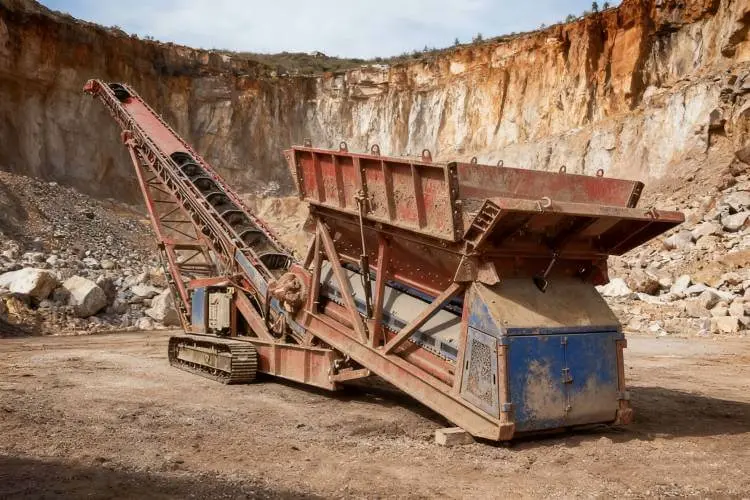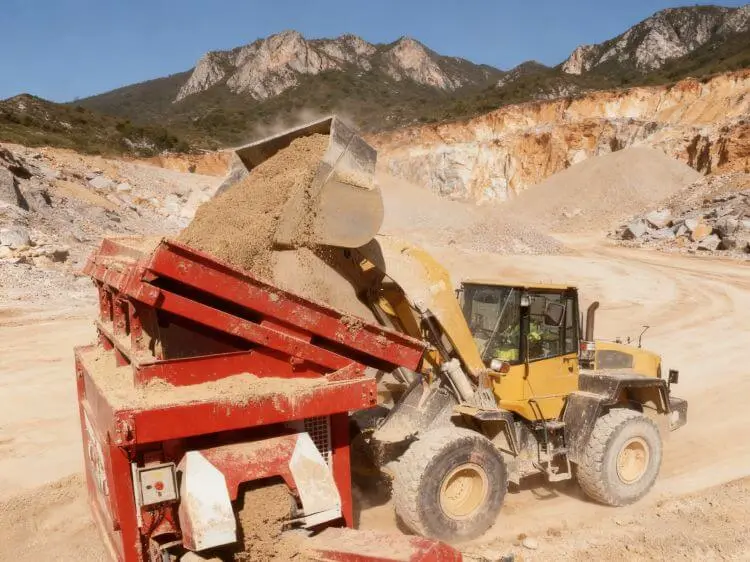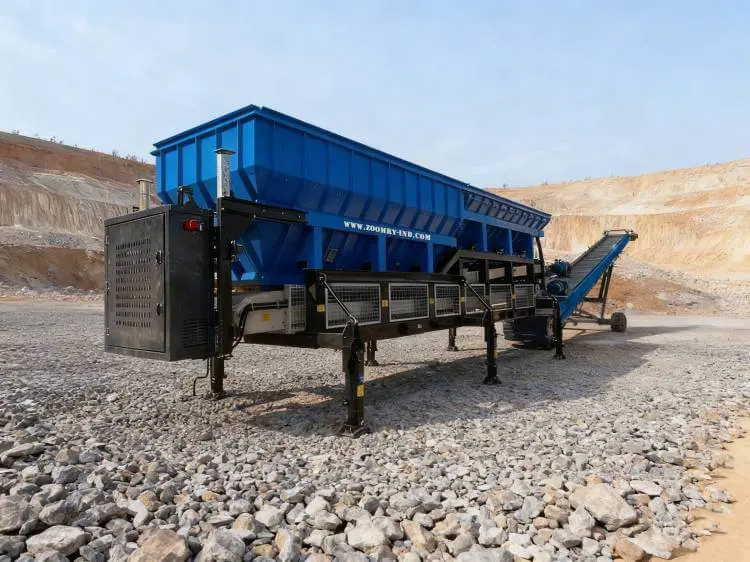Time:2025-11-07 17:12:34 Number of Clicks:
The Heavy Duty Hopper Feeder from ZOOMRY is the core function to precisely receive ores, coal, granite, and other heavy bulk materials transferred by loaders from storage hoppers or work sites, and then convey them continuously and uniformly to downstream processing or transfer equipment such as crushers and belt conveyors, fully undertaking the key link of "raw material reception - directed conveyance."
In mine operations, bulk materials generally have large particle sizes (some up to 250 mm), heavy single weights, and high conveyance demands, and the operation environment often accompanies high-intensity dust, large diurnal temperature differences, uneven ground, and other harsh conditions. Traditional feeding equipment often suffers from insufficient bearing capacity and uncontrolled feeding rhythm, leading to jamming, material accumulation, and fluctuating conveyance speed, directly causing downstream equipment overload shutdown or capacity waste. The Heavy Duty Hopper Feeder from ZOOMRY, through strong bearing structure and precise speed regulation system, can stably receive impacts from large-particle bulk materials while achieving uniform feeding to avoid faults in downstream equipment due to uneven feed, and with its dust-resistant, heat-resistant adaptability, maintains continuous operation in harsh conditions, laying a solid foundation for the efficient and stable operation of the entire mining production line.
In addition to mining scenarios, the Heavy Duty Hopper Feeder can also adapt to similar high-load operations like port bulk material transfer; its maximum 300 TPH (tons/hour) handling capacity can match the continuous production rhythm of large-scale mines, and the ≤250 mm feed size can cover the majority of aggregate specifications in mines without additional pre-processing of raw materials, substantially shortening the operation process and becoming an important equipment selection for global mining enterprises to enhance production efficiency and reduce operational risks.

Hopper Device: Capacity up to 12-24 m³, can achieve raw material buffering, reducing the frequency of loader feeding, adapting to the rapid unloading demands of large-capacity wheeled loaders, avoiding material accumulation and blockage.
Feeding System: Provides two options of heavy-duty belt and chain plate; belt feeding is suitable for smooth conveyance of medium-hardness bulk materials, chain plate feeding is welded from alloy steel plates, with high strength and wear resistance, capable of coping with the impact and friction of large-particle ores.
Drive System: Dual-motor drive design, supporting electric or hydraulic drive mode selection, with strong and stable power output, flexible speed adjustment according to downstream equipment demands.
Support and Mobile Structure: 15-24 m inclined arm can adapt to 5.5-8.2 m unloading heights, wheel or track chassis options give the equipment flexible mobility, allowing quick position adjustment according to changes in mine work points.
Protection System: IP65 (NEMA-4 level) protection rating ensures electrical system and moving parts are exempt from dust and moisture corrosion, adapting to the harsh outdoor operation environment of mines.
Common material impacts, dust pollution, uneven ground, and other problems in mine operations are all targeted in the equipment design. For example, the hopper interior uses wear-resistant lining to reduce impact damage from large ore blocks falling; chain plate connections use high-strength bolts with expansion sleeve keyless connection technology, convenient disassembly and reliable strength; the dual-motor variable frequency control design can achieve smooth speed regulation of feeding, avoiding overload of downstream crushers due to too fast feeding, or capacity waste due to too slow feeding.
The operation process of the Heavy Duty Hopper Feeder from ZOOMRY in mines follows the logic of "raw material reception - buffering regulation - precise conveyance - safety linkage," ensuring every link efficiently matches the mine production rhythm. The specific process is as follows:
Before operation, complete full equipment inspection and debugging to ensure compliance with mine safety operation norms:
Check the fastening of foundation bolts, oil level of drive device, integrity of lubrication system, and tension of chain plate or belt to avoid component loosening or jamming during operation.
Confirm that the interlock control signals with upstream and downstream equipment are normal, and emergency stop devices are installed in conspicuous and easy-to-operate positions, complying with EN 1009-2:2020 international safety standard requirements.
No-load trial run for no less than 2 hours, checking operation noise (not exceeding 85 dB(A)), bearing temperature rise (not exceeding 30℃), and other indicators to ensure no abnormalities before entering load operation state.
Common large-capacity wheeled loaders, excavators, and other transfer equipment in mines will transfer the excavated iron ore, coal, granite, and other raw materials to the hopper of the Heavy Duty Hopper Feeder. The equipment is equipped with a large-capacity hopper of 12-24 m³, which can achieve centralized temporary storage of raw materials, without requiring the transfer equipment to wait for unloading for a long time, effectively reducing equipment idle time and significantly improving the overall feeding link operation efficiency.
The hopper design considers material flow characteristics to avoid freezing or accumulation of damp or sticky materials inside the bin; during winter operations, residual materials in the bin can be cleaned in advance to prevent freezing jamming upon startup.
When starting the equipment, follow the principle of "from bottom to top in the opposite direction of ore flow"; after downstream crushers, belt conveyors, mobile ship loaders, and other equipment are started normally, then start the Heavy Duty Hopper Feeder to avoid raw material accumulation in downstream equipment that is not ready.
The dual-motor drive system adjusts feeding speed according to production demands, achieving precise matching of feeding volume through variable frequency control, with maximum handling capacity up to 3000 TPH, ensuring uniform raw material conveyance to downstream equipment and improving crushing or transfer efficiency.
For large-particle ores (≤250 mm), the chain plate feeding system uses high-strength alloy chain plates to carry materials, utilizing the meshing transmission of sprockets and chains to achieve smooth material conveyance, avoiding belt slippage or material spillage; the belt feeding system reduces material wear on the equipment through wear-resistant belt, suitable for efficient conveyance of medium-hardness bulk materials.
During equipment operation, maintain linkage with upstream and downstream equipment through interlock control signals; when downstream equipment fails, the feeder can automatically slow down or stop to avoid raw material accumulation causing equipment damage.
If large ore blocks block the feed inlet or discharge outlet, the equipment will issue an alarm signal; operators must stop and cut off power per regulations before processing, and processing requires at least two people, with at least one supervising to ensure operation safety.
Strictly prohibit cleaning, maintenance, or repair during equipment operation; all moving parts are equipped with reliable protective devices to prevent accidental personnel contact causing injury, complying with international safety standard requirements for mechanical protection.
When parking, follow the principle of "from top to bottom in the direction of ore flow": first stop the feeder feeding, wait until raw materials in the hopper are basically conveyed, then shut down the equipment to avoid raw material residue leading to difficulties in next startup.
After operation, clean the ore, dust, and oil stains on the equipment surface, check wear of vulnerable parts like chain plates and belts, and perform lubrication maintenance and operation records to prepare for the next operation.

The maximum 3000 TPH handling capacity meets the demands of large-scale mining operations, with significantly higher capacity compared to traditional feeding equipment, matching the continuous production rhythm of large mines.
Capable of handling large particle sizes of ≤250 mm without prior crushing pre-processing of raw materials, reducing intermediate operation links and shortening the production cycle.
IP65 (NEMA-4 level) protection rating and high-strength structural design enable stable operation in multi-dust, high-temperature, damp, and other harsh mine environments, reducing faults and shutdowns due to environmental factors.
The chain plate is made from high-strength steel no less than Q235, with sprocket life no less than 5 years and chain plate life no less than 3 years; the overall equipment service period before scrapping can reach 10 years, lowering equipment replacement frequency and maintenance costs.
Wheel or track chassis options allow the equipment to flexibly move according to changes in mine work points, without fixed installation foundation, adapting to different mine site conditions.
The 15-24 m inclined arm and 5.5-8.2 m unloading height can flexibly adapt to different heights of downstream conveying equipment, reducing the modification difficulty of mine production lines.
The variable frequency operation is simple and easy to understand, and operators can go on duty after training; the equipment operation status can be real-time monitored through the interlock control system, facilitating timely discovery and handling of abnormalities.
The product complies with EN 1009-2:2020 international standard and JB/T 4040 industry standard, through type testing and production process quality control, ensuring product quality consistency and reliability, and can freely circulate in the global market.
The complete safety protection design, including emergency stop devices, moving parts guardrails, interlock alarm systems, etc., maximizes personnel safety assurance and reduces mine operation risks.
To ensure long-term stable operation of the Heavy Duty Hopper Feeder in mines and extend equipment service life, follow scientific maintenance principles and operation norms; the core points are as follows:
Regularly check the lubrication system to ensure sufficient lubrication for key components like drive devices, sprockets, and bearings, avoiding dry friction leading to accelerated component wear.
Weekly check the tension and wear of chain plates or belts, tightening loose bolts in time, and timely replacing severely worn or broken ones to avoid triggering equipment faults.
Regularly clean residual materials inside the hopper and on the equipment surface to prevent damp or sticky materials from freezing or clumping, affecting normal equipment operation.
Operators must hold certificates to go on duty, wear complete labor protection gear, strictly prohibit alcohol or fatigue on duty, and concentrate during work to avoid irregular operations.
Strictly prohibit cleaning, maintenance, or repair during equipment operation; do not use hands or tools to directly contact moving parts; when handling material blockages, must first stop and cut off power, and set at least two people for operation, with at least one supervising to ensure operation safety.
Strictly comply with shift handover system, detailed recording of equipment operation status, existing hazards, and handling situations to ensure continuous transmission of operation information.
Perform regular overhaul according to the equipment manual; the first overhaul life is no less than 14000 hours; during overhaul, fully disassemble and inspect the equipment, replace aging parts, and restore equipment performance.
When the equipment is out of service for a long time, it should be stored in a sheltered, damp-proof place; electrical equipment must be kept dry and ventilated, exposed machined surfaces coated with anti-rust grease to prevent component corrosion.
According to mine material characteristics (such as corrosivity, high hardness, etc.), regularly replace wear-resistant lining, chain plates, and other vulnerable parts to avoid affecting equipment conveyance efficiency and safety due to component wear.

ZOOMRY has been deeply engaged in the field of bulk material conveying equipment for many years. In addition to the Heavy Duty Hopper Feeder, it also provides complete bulk material conveying solutions such as belt conveyors, bucket wheel stacker reclaimers, truck unloaders, and supporting parts like idlers, rollers, cleaning scrapers, etc., meeting the full-process operation demands of mines.
All Heavy Duty Hopper Feeders are manufactured according to approved drawings and technical documents, and undergo strict type testing and factory acceptance testing before leaving the factory, ensuring compliance with international standards and industry norms. Under the condition that the user complies with storage, installation, and use rules, if due to poor manufacturing quality, damage or inability to operate normally within 24 months from the date of shipment, or 18 months from the date of installation and use, ZOOMRY will be responsible for free repair or replacement of the product and parts.
Providing all-round technical support services for global customers, including equipment installation guidance, operator training, operation process optimization, etc., helping customers quickly master equipment use and maintenance skills to ensure optimal performance. For different mine site conditions, customized equipment adjustment solutions can be provided to adapt to customers' personalized production needs.
The Heavy Duty Hopper Feeder, as the "throat" equipment of mine bulk material conveyance, its operation efficiency and stability directly affect the overall capacity and operational costs of the mine. The Heavy Duty Hopper Feeder from ZOOMRY, through scientific structural design, high-load adaptation capability, and strict quality control, perfectly matches the operation demands in harsh mine conditions, providing efficient and reliable feeding solutions for global mining enterprises. If you need further understanding of equipment selection adaptation, technical parameter details, or customized solutions, welcome to contact the professional team of ZOOMRY.
Copyright © 2002-2024 Zoomry Group Company Limited